Global use of feed materials in the production of animal feed is
increasing the risk of chemical and microbiological contaminants
in food-producing animals.
The feed can be contaminated with microorganisms, mycotoxins,
animal by-products, organic pollutants and toxic metals. Mycotoxin contamination is now recognized as a global issue
in agricultural production, especially in the livestock sector.
PATENT CO, Serbia

Mycotoxins
Mycotoxins are secondary metabolites that are produced by moulds stressed by environmental and management factors, such as extreme temperatures, drought, flooding and harvesting techniques.
In this article we are going to focus on analysis of mycotoxins, in vitro and in vivo studies carried on MINAZEL PLUS, obtained by organic modification of the surface of clinoptilolite, known for its capacity of adsorbing polar and non-polar mycotoxins.
In the following trials, MINAZEL PLUS, which is referred to as MP, was used.
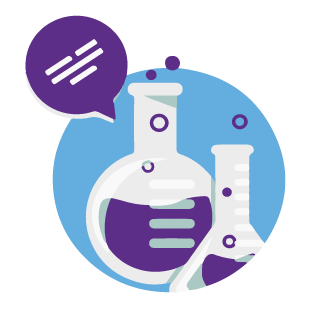
Test in vitro with ADSORPTION & DESORPTION
LESS POLAR MYCOTOXIN ADSORPTION
MINAZEL PLUS is a result of organic
modification of clinoptilolite surface,
well known for adsorbing polar and
non-polar mycotoxins.
Once adsorbed to the clinoptilolite, mycotoxins are not desorbed through the intestinal tract.
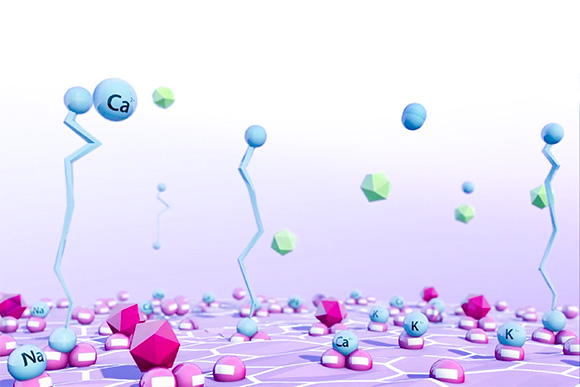
pH
The adsorbent MP is highly effective across a wide spectrum pH range as it absorbs a greater percentage of mycotoxins in low pH gastric juices and does not desorb mycotoxins in the presence of intestinal juices where pH is close to neutral.
ADSORPTION/DESORPTION
The analysis carried out in our laboratory using LC-MS/MS (Combined analysis with Liquid Chromatography and Mass Spectrometry) and have revealed that MP can adsorb all major mycotoxins more than 80% with very low desorption.
Adsorbent(%)
The adsorbent MP can adsorb in the in vitro studies:
- 100% of AFB1
- 88% of Zearalenone
- 91% of Ochratoxin A
- 98% of FB1
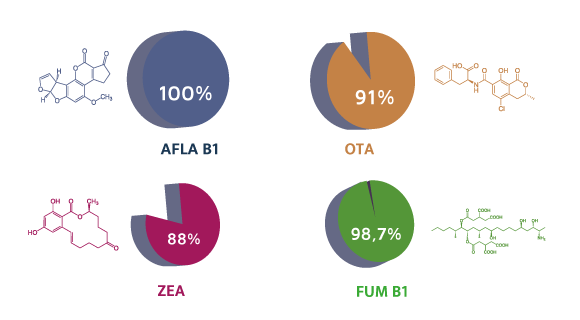
Desorption(%)
- 0% for AFB1
- 2,3% for Zearalenone
- 1,0% for Ocratoxina A
- 3,9% for FB1
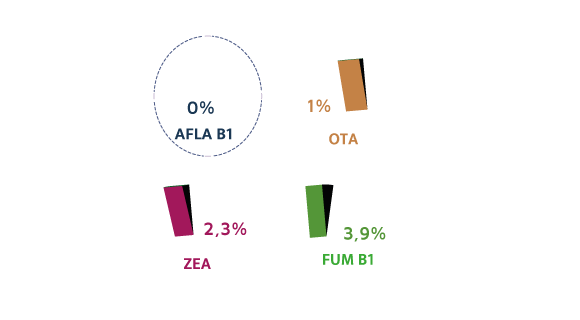
SPEED OF ADSORPTION
Exposure to mycotoxins is mostly by ingestion. Only the
fraction of an orally ingested mycotoxin, in a certain food
matrix, that finally reaches the systemic circulation and is
distributed throughout the entire body, exert its toxic effect.
The bioaccessibility of the mycotoxins corresponds with the
number mycotoxins present in the alimentary bolus and that
are available for absorption in the small intestine. Certain
mycotoxins are absorbed faster after oral intake. After 30 min
they can be found in the blood, and after 60 min in the liver.

Speed of adsorption (LC-MS/MS)
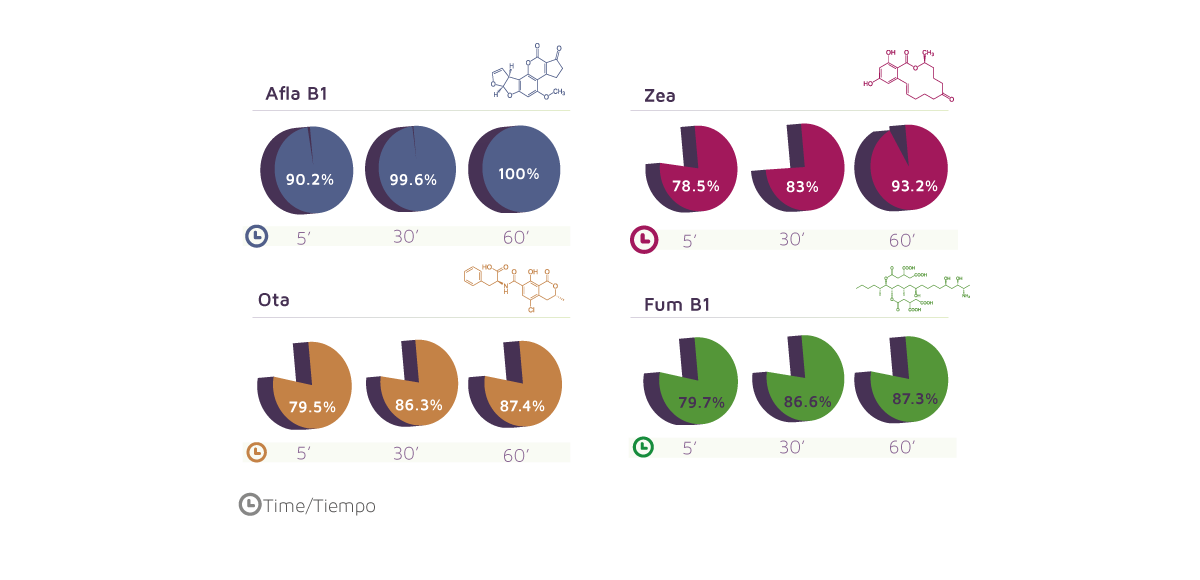
In vivo studies
AIM
MATERIAL & METHODS
Animals
48 laying hens (27-week-old)
were used in this study.
TREATMENTS & DIETS
The hens were randomly divided
to six equal groups and were
fed during 7 weeks with
the following diets:
- Negative Control - Standard diet without mycotoxins
- Treatment I - Standard diet + 1 mg/kg OTA
- Treatment II - Standard diet + 0,25 mg/kg OTA
- Treatment III - Standard diet + 0,25mg/kg OTA + 0,2% MP
- Treatment IV - Standard diet + 1 mg/kg OTA + 0,2% MP
- Positive Control - Standard diet without mycotoxins + 0,2% MP
Influence of OTA on production parameters (body weight, feed consumption, number and mass of eggs) was monitored.
Table 1. Body weight of laying hens during the trial (g).
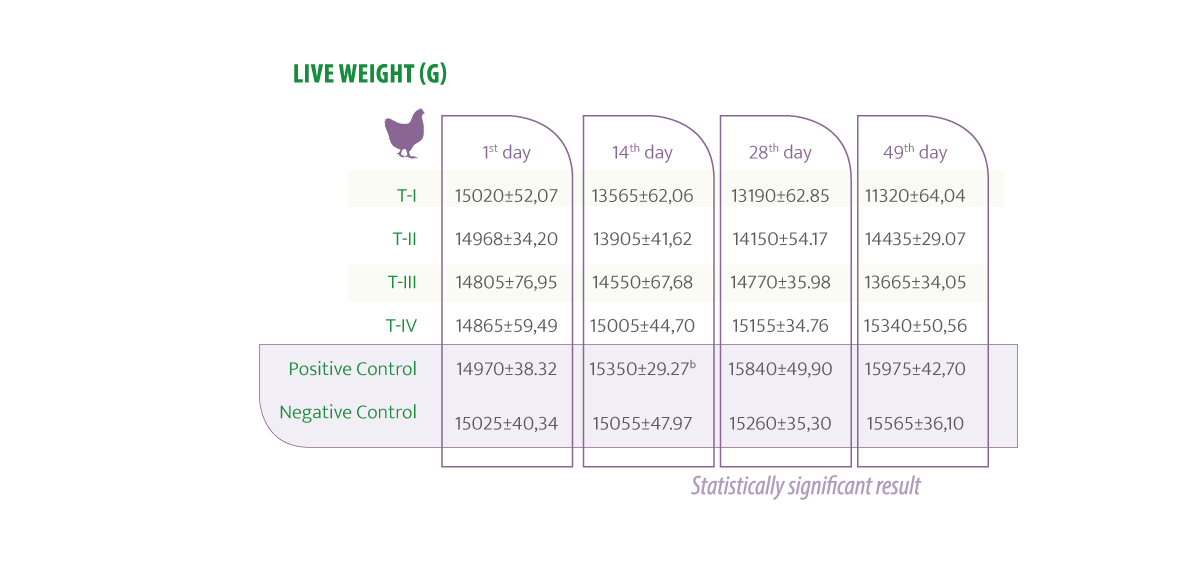
RESULTS
The supplementation of MP in the standard diet, by itself resulted in the higher body weight, number of eggs and improved feed conversion ratio than in the control group of hens (fed with standard diet without any addition).
During the experiment, starting from the second week, the BW of hens was significantly lower in T-I group in relation to all other experimental and control groups.
Also, a group of hens which received just the adsorbent MP in commercial diet, had significantly higher BW compared to the hens in T-I, T-II and T-III group (Table 1).
Compared to the all experimental and control group, feed consumption was significantly lower in the hens that received diet with 1 mg/kg of OTA.
Also, the hens of T-II group, which are given diet with 0,25 mg/kg OTA, had periodically lower BW in comparison with the hens in T-III, T-IV group, as well as in comparison with hens in the MP and Positive Control groups.
Table 2. Feed consumption (g). These results are consistent with the data of Duarte et al. (2011) and Denli et al. (2008) Datos estadísticamente signi cativos

Number of eggs in T-I group during the 2nd and 3rd weeks of the study, was significantly lower than the number of eggs in the other experimental and control groups. This trend continued until the end of the experiment.
It is interesting that a group of hens which received 1 mg/kg OTA + 0,2% MP (T-III), produced a significantly higher number of eggs in relation to T-I group. This result indicates the achievement of the protective effect of the mycotoxin binder against OTA in the feed of hens.
The highest number of eggs produced hens that have received commercial diet containing 0.2% MP.
Table 3.Number of eggs, Statistically significant results. These results are consistent with the data of Duarte et al. (2011) and Denli et al. (2008)

CONCLUSIONS
The addition of MP 0,2% in the feed, improves all production parameters in laying hens, regardless of whether they are fed with or without OTA.
The feed consumption in hens treated with OTA was lower compared to the results in other groups.
Adding MP in food contaminated with OTA showed a protective action with respect to harmful effects of mycotoxins on the observed physiological parameters in hens. A clear protective effect against OTA by the adsorbent MP was exhibited on the number of laid eggs.
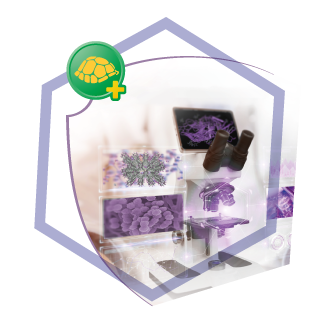



 Micotoxicosis prevention
Micotoxicosis prevention